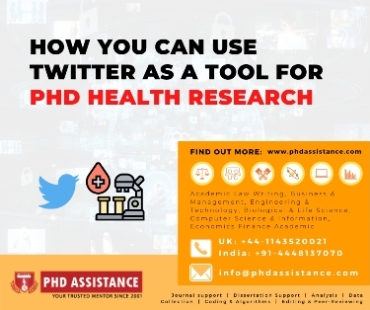In brief
- We explore the rapidly growing field of using social media especially Twitter as a source of data for Health and Medicine related Research.
- The types of data available and their application, the limitations in Methodology and standard guidelines with future areas of research are highlighted.

Reality of the virtual world- an oxymoron.
No one can escape living in the virtual world today. The virtual world is brimming with Information and knowledge whose scope is much beyond one had imagined even till five years ago. In their attempts to find comprehensive databases, health workers and researchers are tapping the potential of these major interactive sites. These sites transcend geography and hold the potential in providing significant data related to population health, preferences, trends, and behaviour patterns. Predominant among these are Facebook, Instagram, and Twitter with Twitter being the most used for public health research (Alshaikh, Ramzan, Rawaf, & Majeed, 2014).
“Tweet” “Tweet”
Twitter is a social media interacting site based out of San Francisco with over 25 offices worldwide. Users register and can post their messages or ‘tweets’ of up to 280 characters while interacting with each other. It is termed as ‘SMS of the internet’ due to the large number of registered users running into hundreds of millions. It is the most widely used social medium for Research related to Healthcare, because of the ease of access to huge amount of data available to open access (Twitter, 2020). Also,
- Tweets are consistent in length, machine learning methods work better,
- Data is real-time, making time series analysis possible,
- Interaction between people allows better network analysis,
- Almost 100% data available through API,
- Uses hastag# making search by key words easy,
- Sentiment analysis is easy with the ‘like’, ‘dislike’ feature,
- Larger demographic group involved,
- Any user can follow another user.
It is for the above reasons that though Twitter is not as widely used as Facebook or WhatsApp, still it is the one that has attracted Academics and Researchers the most, making it a powerful tool for research data (Neiger, Thackeray, Burton, Giraud-Carrier, & Fagen, 2013).
What to use and how?
Sinnenberg et al performed a systematic review of the studies conducted using Twitter as a tool for health research. They summarized the ways in which data from Twitter was used for purpose of research (Sinnenberg et al., 2017): –
- Content analysis – here body of text is analysed and information relevant to the topic is used. E.g. Content related to a health topic like obesity or cancer.
- Sentiment analysis – The positive or negative agreement to the topic in question is analysed and data is used. E.g. ‘High traffic’ topics fund best research thesis.
- Image analysis –Assessment of images in the body of the text is analysed in the context of the topic.
- Surveillance – Monitoring the level of activity related to the topic in relation to the background level of activity. E.g. Dissertation topic selection can be done based on the ‘hot’ topics on social media.
- Prediction – Estimating prevalence of a condition
- Engagement–Ability of a topic to engage users to tweet, retweet and remain engaged in the discussion with other users.
- Network analysis – Assessing interaction between users on a topic.
- Recruitment (Fenner et al., 2012) – Using the platform to recruit subjects for a research study. E.g. recruitment of study population having a rare condition.
- Intervention (Hawn, 2009) – Using the platform to intervene in a research study. E.g. weight loss, nutrition, smoking cessation related interventions and their outcome study. This could form a unique method for PhD statistics topic selection support (Balatsoukas, Kennedy, Buchan, Powell, & Ainsworth, 2015).
- Ethical discussion – Studying the need for approvals from ethical boards. E.g. Whether online or written patient consent is needed for research. Consent for using Twitter data in addition to the terms and conditions of service agreement at the time of user registration.
- Funding – Database of organizations funding research work.
- Computing Dissertation topic selection performed on the Twitter-based research is commonly related to public health, infectious disease, behavioural medicine, and psychiatry.
The road ahead
- Standard processes for how the Twitter data should be used is not defined. There needs to be uniform reporting procedures clearly defined and agreed upon. Time-to-time these SOPs need to be revisited and redone based on lessons learnt in the interim period (Tsou, 2015).
- Criteria for validity, reliability and scalability of Twitter-driven data need to be studied and several organizations are actively involved in funding such research.
- Also, privacy of data and ethical issues is a broad field where clear-cut guidelines are needed.
- Underutilisation of Twitter data is another area of concern and guidelines regarding the same are the need of the hour. Twitter API vis-à-vis Twitter firehose accessing 1% and complete data, respectively.
- Twitter’s data sharing policy and affordances of the public API make the database for research complicated and one needs to be aware of these limitations to understand the factors that can skew the research study.
- Machine learning involving data scientists for better understanding of the demographic data of the users participating in the research.
- Better use of the platform to study chronic illnesses like diabetes and hypertension.
- Studying the effectiveness of using Twitter-based data for medical research.
And so
Twitter-based Medical Research is a rapidly growing niche area with publications almost doubling year on year in the last 2-3 years. The huge database with open access along with opportunity for recruitment and intervention are the major selling points for Twitter compared to the other social media sites. However, there are several limitations to the methodology used by the different research groups, the most significant being the lack of standard reporting protocols and there is an urgent need to address this with uniform guidelines.
References
- Alshaikh, F., Ramzan, F., Rawaf, S., & Majeed, A. (2014). Social Network Sites as a Mode to Collect Health Data: A Systematic Review. Journal of Medical Internet Research, 16(7), e171. https://doi.org/10.2196/jmir.3050
- 2. Balatsoukas, P., Kennedy, C. M., Buchan, I., Powell, J., & Ainsworth, J. (2015). The Role of Social Network Technologies in Online Health Promotion: A Narrative Review of Theoretical and Empirical Factors Influencing Intervention Effectiveness. Journal of Medical Internet Research, 17(6), e141. https://doi.org/10.2196/jmir.3662
- Fenner, Y., Garland, S. M., Moore, E. E., Jayasinghe, Y., Fletcher, A., Tabrizi, S. N., … Wark, J. D. (2012). Web-Based Recruiting for Health Research Using a Social Networking Site: An Exploratory Study. Journal of Medical Internet Research, 14(1), e20. https://doi.org/10.2196/jmir.1978
- Hawn, C. (2009). Take Two Aspirin And Tweet Me In The Morning: How Twitter, Facebook, And Other Social Media Are Reshaping Health Care. Health Affairs, 28(2), 361–368. https://doi.org/10.1377/hlthaff.28.2.361
- Neiger, B. L., Thackeray, R., Burton, S. H., Giraud-Carrier, C. G., & Fagen, M. C. (2013). Evaluating social media’s capacity to develop engaged audiences in health promotion settings: use of Twitter metrics as a case study. Health Promotion Practice, 14(2), 157–162. Retrieved from https://journals.sagepub.com/doi/abs/10.1177/1524839912469378
- Sinnenberg, L., Buttenheim, A. M., Padrez, K., Mancheno, C., Ungar, L., & Merchant, R. M. (2017). Twitter as a Tool for Health Research: A Systematic Review. American Journal of Public Health, 107(1), e1–e8. https://doi.org/10.2105/AJPH.2016.303512
- Tsou, M.-H. (2015). Research challenges and opportunities in mapping social media and Big Data. Cartography and Geographic Information Science, 42(sup1), 70–74. Retrieved from https://www.tandfonline.com/doi/abs/10.1080/15230406.2015.1059251
- Twitter. (2020). Our talented and diverse employees work together across 35+ offices worldwide. Retrieved July 4, 2020, from Twitter website: https://about.twitter.com/en_us/company.html
- Guidelines to Write a Research Proposal for Neurology Research Scholars - March 19, 2021
- How to Choose a PhD Dissertation Topic For Economic Research? List out the Criteria for Topic Selection - March 11, 2021
- Beginners Guide to Write a Research Proposal for a PhD in Computer Science - February 19, 2021

